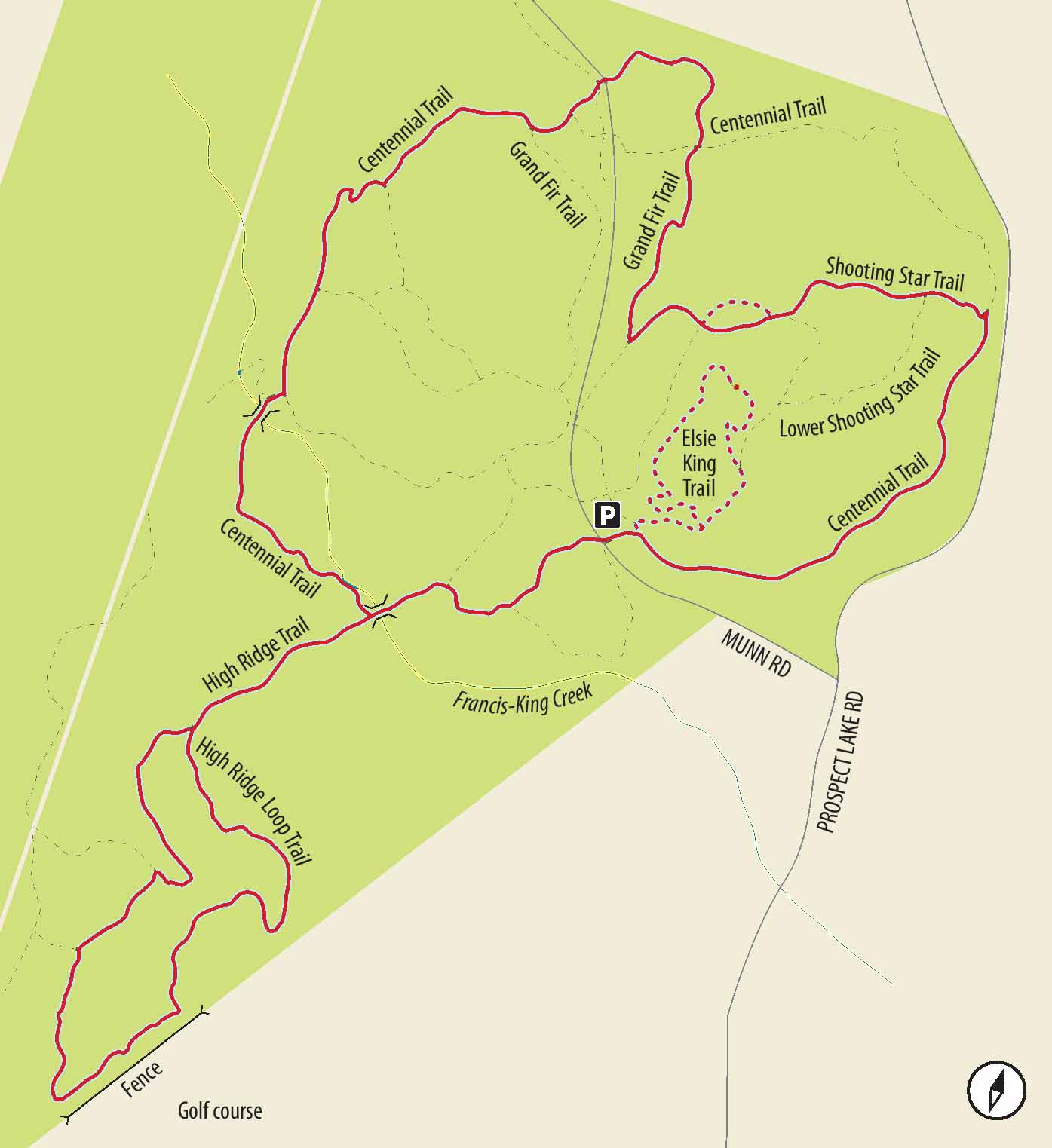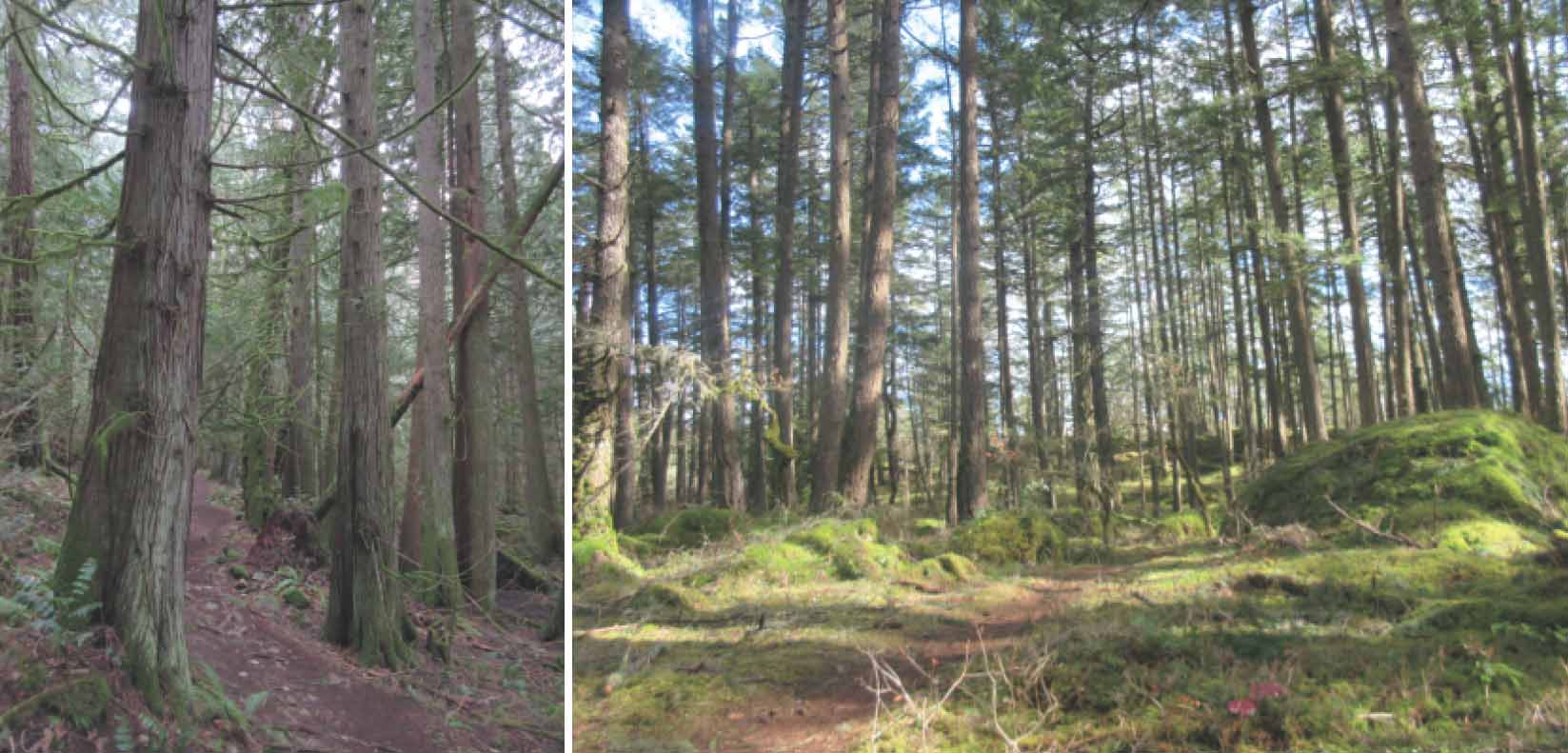
34. FRANCIS/KING REGIONAL PARK
A tree hugger’s paradise! A maze of diverse and carefully signposted trails over knolls and, above all, through gorgeous old trees. The park is named after Thomas Samuel Francis, who donated most of the land that makes up the park, and famous Vancouver Island naturalist Freeman “Skipper” King – hence the oblique in the park’s name.

From Highway 1, heading north from Victoria, take Exit 10 for Burnside Road West. After just under 1.5 km turn left onto Prospect Lake Road and drive 1.2 km. Turn left onto Munn Road and drive 0.5 km. The large Capital Regional District sign for the park is on your right.
DISTANCE
3.4-km loop, plus 1.8-km loop
ELEVATION GAIN
70 m
DIFFICULTY
Mostly easy to moderate, though with some narrow, rooty sections and some noticeable rises, and, seasonally, large muddy sections to wind around.
SEASON
All season, though late spring is best for possibilities of spotting wildflowers, especially on the ridge loop.
OF SPECIAL INTEREST FOR CHILDREN
The 800-m Elsie King loop, along deluxe pathways, can be a good preparation for the longer loops. Absorb some of the natural history from the colourful and colourfully worded signs, and prepare, as a team, to apply that knowledge to finding, for example, “tree’s knees” and “nurse stumps.” The nearby nature centre is open from 12:00 to 4:00 p.m. on weekends and holiday Mondays. For those taking the High Ridge option, llama-spotting is a surprising and delightful possibility!
While several variations are possible through the maze, the suggested route hits many of the best features.
FROM LEFT Stonecrop and licorice ferns on a rocky outcropping along Centennial Trail; even in winter months the rich forest has atmosphere.
1.Find the trailhead for Centennial Trail tucked between the two buildings to your right. The least inspiring part of the whole circuit is the first stretch of narrow trail, largely parallel to the road. Most appealing are little patches of licorice fern and Oregon grape and the increasingly cliffy, moss-covered rocks rising above the trail.
2.Arriving at the signpost for the connector to Shooting Star Trail, turn left to climb up a rocky crest on the narrow, winding trail. When, after a significant climb, you get to the signpost and fork, turn right. The trail takes its name, unsurprisingly, from the striking pink flowers that bloom in early April. This next part of the trail is largely level, under open, established forest with some stately old firs. Look for the blackened burn scars on one impressive specimen just before descending to the junction with Lower Shooting Star Trail. Keep ahead, though, when you reach the junction with Skunk Cabbage Loop, you may wish to take this alternative if you arrive in spring (or even summer).
3.Continuing your descent past a snag with bracket fungus, follow signs via a connector trail to Grand Fir Trail. Turn right to walk a low, damp section of land through probably the best stand of grand fir on any park trail in the lower part of Vancouver Island.
4.When, however, you get to a bit of unsignposted trail leading to a cross trail, rejoin Centennial Trail and turn left. Climb up and over a pretty, little mossy knoll and, within a short distance, turn left to cross Munn Road. Go straight ahead on Centennial Trail. As the trail curves gradually to the left, pass two side trails simply labelled “Parking Lot.” Between the two, the smaller members of your expedition should be thrilled to discover a little cave. Be glad you brought your camera.
5.As you drop into lower and damper ground, notice the increasing number of moisture-loving cedars. One of these, shortly after the second connector trail to the parking lot, is particularly striking for its partially rotted trunk and many woodpecker holes. At the junction with the third Parking Lot trail, turn sharply to the right to cross a low bridge and a seasonal mud-o-rama.
6.From here the trail takes on a new aspect, since the uphill slope is now on your right. At the next signposted junction, you have a decision to make: trot the 370 m back to the parking lot, or sally forth onto High Ridge Trail. In making your decision, don’t be misled by the name. The trail is neither very high, nor is the “ridge” much more than a generally raised area of rounded mossy knolls. The views are almost entirely of trees rather than distant vistas. On the other hand, the woods along the route are probably the prettiest in the park.
7.Assuming you are going to go the whole hog, begin your new adventure by crossing a little bridge and, in winter, navigating your way through a bit of a muddy mess. Take heart. You soon begin the gradual climb along lovely trail to the fork leading to High Ridge Loop Trail. For now, turn right, to walk the loop counter-clockwise. Be pleased that you chose to come here as you walk through what many would consider the prettiest part of the whole trail system.
8.After a deep bend around a pond, the trail comes to a T junction. Mystifyingly (at least in terms of the official park map), both right and left are High Ridge Loop Trail. Turn left to begin the last phase of the loop. Pass over an enchanting mossy crest and, shortly after, some especially masterly old firs. Ignore a signposted trail on the right pointing to Thetis Lake Park (though keep the spot in mind for other possible adventures in route finding).

FROM LEFT The northwest part of Centennial Trail passes many fine cedars; the forest is generally open and light along High Ridge Loop Trail.
9.Brace yourself for a bit of a shock as you come to a fence and vehement Private Property signs keeping you from trespassing onto the groomed lawns of a golf course. After winding back and forth along this barrier, come to a charming little farm with – usually visible – llamas! Heading back to complete the ridge loop takes you past an intriguing woodpecker-pitted fir almost directly on the trail.
10.Navigating your way back across the mud, and regaining Centennial Trail, turn right to pass some boardwalks and ascend through the open stands of cedar to the beginning. Don’t be in such a rush, however, that you miss one of the last delights of this part of the trail: the multi-trunked Six Sisters cedar just off the right of the trail.